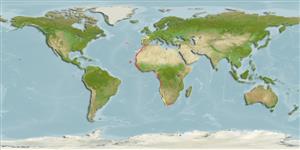>
Carangiformes (Jacks) >
Carangidae (Jacks and pompanos) > Naucratinae
Etymology: Seriola: Latin word diminutive with the meaning of a large earthenware pot (Ref. 45335).
Environment: milieu / climate zone / depth range / distribution range
Écologie
marin benthopélagique; profondeur 0 - 200 m (Ref. 26999). Subtropical; 18°C - 27°C (Ref. 43448)
Eastern Atlantic: Bay of Biscay and Agadir, Morocco to Angola, including Cape Verde (Ref. 4233). Migrants were caught around Lampedusa Island (Mediterranean Sea) (Ref. 38310).
Taille / Poids / Âge
Maturity: Lm ? range ? - ? cm
Max length : 72.5 cm TL mâle / non sexé; (Ref. 38310); common length : 40.0 cm TL mâle / non sexé; (Ref. 26999)
Épines dorsales (Total): 8 - 9; Rayons mous dorsaux (Total): 28-33; Rayons mous anaux: 17 - 21
Adults are generally confined only in coastal waters over continental shelf, from the surface to at least 200 m. They feed on squids and fishes. Are confined to areas where surface temperature exceed 25°C, their distribution perhaps influenced by seasonal movements of the 18-27°C water mass along the African coast (Ref. 4233). Eggs are pelagic (Ref. 4233).
Life cycle and mating behavior
Maturité | Reproduction | Frai | Œufs | Fécondité | Larves
Smith-Vaniz, W.F., 1986. Carangidae. p. 815-844. In P.J.P. Whitehead, M.-L. Bauchot, J.-C. Hureau, J. Nielsen and E. Tortonese (eds.) Fishes of the north-eastern Atlantic and the Mediterranean. UNESCO, Paris. vol. 2. (Ref. 4233)
Statut dans la liste rouge de l'IUCN (Ref. 130435)
Menace pour l'homme
Reports of ciguatera poisoning (Ref. 30298)
Utilisations par l'homme
Pêcheries: commercial; pêche sportive: oui
Plus d'informations
Noms communsSynonymesMétabolismePrédateursÉcotoxicologieReproductionMaturitéFraiRassemblement de ponteFéconditéŒufsDéveloppement de l'œuf
RéférencesAquacultureProfil d'aquacultureSouchesGénétiqueElectrophoresesHéritabilitéPathologiesTraitementNutrientsMass conversion
Outils
Articles particuliers
Télécharger en XML
Sources Internet
Estimates based on models
Preferred temperature (Ref.
123201): 15.6 - 24.5, mean 18.7 °C (based on 118 cells).
Phylogenetic diversity index (Ref.
82804): PD
50 = 0.5020 [Uniqueness, from 0.5 = low to 2.0 = high].
Bayesian length-weight: a=0.01413 (0.00618 - 0.03226), b=2.94 (2.74 - 3.14), in cm total length, based on LWR estimates for this (Sub)family-body shape (Ref.
93245).
Niveau trophique (Ref.
69278): 4.6 ±0.59 se; based on food items.
Résilience (Ref.
120179): Milieu, temps minimum de doublement de population : 1,4 à 4,4 années (Preliminary K or Fecundity.).
Fishing Vulnerability (Ref.
59153): Moderate to high vulnerability (49 of 100).
Nutrients (Ref.
124155): Calcium = 49.3 [30.1, 103.4] mg/100g; Iron = 1.09 [0.61, 1.97] mg/100g; Protein = 18.2 [15.3, 21.1] %; Omega3 = 0.404 [0.247, 0.675] g/100g; Selenium = 35.6 [18.6, 68.4] μg/100g; VitaminA = 52.4 [7.0, 375.9] μg/100g; Zinc = 0.519 [0.365, 0.749] mg/100g (wet weight);
